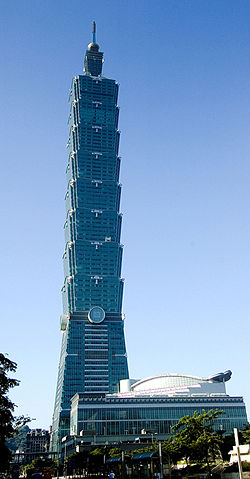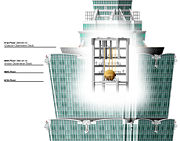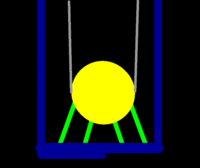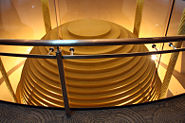|
|
|
|
|
|
|
|
|
|
|
|
Taipei 101Taiwan - Asia

Taipei 101 has been the world's tallest building since 2004 The building, designed by C.Y. Lee & Partners and constructed by KTRT Joint Venture, is the world's tallest completed skyscraper. Taipei 101 received the Emporis Skyscraper Award in 2004. It has been hailed as one of the Seven New Wonders of the World (Newsweek magazine, 2006) and Seven Wonders of Engineering (Discovery Channel, 2005). The building stands as an icon of Taipei and Taiwan as a whole. Its postmodern style combines tradition and modernity in ways that make it Asian and international both at once. Its safety features enable it to withstand typhoons and earthquakes. A multi-level shopping mall adjoining the tower houses hundreds of fashionable stores, restaurants and clubs. Fireworks launched from Taipei 101 feature prominently in international New Year's Eve broadcasts, and the landmark appears frequently in films, television shows, print publications, anime media, games, and other elements of popular culture. The name of the tower reflects its location in Taipei's 101 business district and its floor count. The number is pronounced in English simply as One Oh One and in Mandarin by the equivalent. Taipei 101 is owned by the Taipei Financial Centre Corporation and managed by the International division of Urban Retail Properties Corporation based in Chicago USA. The name originally planned for the building, Taipei World Financial Centre, was derived from the name of the owner. The original name in Chinese was literally, Taipei International Financial Centre Taipei 101 was overtaken in height on July 21, 2007 by the Burj Dubai in Dubai, UAE, upon the completion of that building's 141st floor. The title of "world's tallest building" still rests with Taipei 101, though, as international architectural standards define a "building" as a structure capable of being fully occupied. The Burj Dubai is on course to claim the title once its construction is finished. Location Taipei, Taiwan Status Complete Constructed 1999-2004 Height Technical details Elevator count 61, including double-deck shuttles and 2 high speed observatory elevators) Cost US$1,758,000,000 Architect C.Y. Lee Contractor KTRT Joint Venture Height Taipei 101 has 101 stories above ground and five underground. Upon its completion Taipei 101 claimed the official records for: Ground to highest architectural structure (spire): 509.2 metres (1,670.60 ft). Previously held by the Petronas Towers 452 m (1,483 ft). Ground to roof: 449.2 m (1,473.75 ft). Formerly held by the Sears Tower 442 m (1,450 ft). Ground to highest occupied floor: 439.2 m (1,440.94 ft). Formerly held by the Sears Tower 412.4 m (1,353 ft). Fastest ascending elevator speed: 16.83 m (55.22 ft) (60.6 km/h, 37.7 mi/h). Largest countdown clock: On display every New Year's Eve. The record for greatest height from ground to pinnacle remained with the Sears Tower in Chicago 527 m (1,729 ft). Taipei 101 was the first building in the world to break the half-kilometre mark in height. It was the first "world's tallest building" to be constructed in the new millennium. Taipei 101 displaced the Petronas Towers in Kuala Lumpur, Malaysia, as the tallest building in the world by 57.2 m (188 ft). It also displaced the 85-story, 347.5 m (1,140 ft) Tuntex Sky Tower in Kaohsiung as the tallest building in Taiwan and the 51-story, 244.2 m (801 ft) Shin Kong Life Tower as the tallest building in Taipei. The Burj Dubai, located in Dubai, UAE, overtook Taipei 101 in height upon completion of its 141st floor on July 7 2007. The Burj Dubai is expected to hold a number of world records by the time it opens in mid-2009. Taipei 101 retains its official title until the Burj Dubai is completed, however, as the Council on Tall Buildings and Urban Habitat does not officially recognize a structure as a "building" for record purposes until it is functional that is, until it is completed and can be occupied. Various sources, including the building's owners, give the height of Taipei 101 as 508.0 m (1,667 ft), roof height and top floor height as 448.0 m (1,470 ft) and 438.0 m (1,437 ft). This lower figure is derived by measuring from the top of a 1.2 m (4 ft) platform at the base. CTBUH standards, though, include the height of the platform in calculating the overall height, as it represents part of the man-made structure and is above the level of the surrounding pavement. 
Location of Taipei 101's largest tuned mass damper Taipei 101 is designed to withstand the typhoon winds and earthquake tremors common in its area of the Asia-Pacific. Planners aimed for a structure that could withstand gale winds of 60 m (197 ft) per second (216 km/h, 134 mi/h) and the strongest earthquakes likely to occur in a 2,500 year cycle. Skyscrapers must be flexible in strong winds yet remain rigid enough to prevent large sideways movement (lateral drift). Flexibility prevents structural damage while resistance ensures comfort for the occupants and protection of glass, curtain walls and other features. Most designs achieve the necessary strength by enlarging critical structural elements such as bracing. The extraordinary height of Taipei 101 combined with the demands of its environment called for additional innovations on the part of engineers. The design achieves both strength and flexibility for the tower through the use of high-performance steel construction. Thirty-six columns support Taipei 101, including eight "mega-columns" packed with 10,000-psi concrete. Every eight floors, outrigger trusses connect the columns in the building's core to those on the exterior. These features combine with the solidity of its foundation to make Taipei 101 one of the most stable buildings ever constructed. The foundation is reinforced by 380 piles driven 80 m (262 ft) into the ground, extending as far as 30 m (98 ft) into the bedrock. Each pile is 1.5 m (5 ft) in diameter and can bear a load of 1100-1450 tons. The stability of the design became evident during construction when, on March 31 2002, a 6.8-magnitude earthquake rocked Taipei. The tremor was strong enough to topple two construction cranes from the 56th floor, then the highest, and killed five people in the accident. An inspection afterwards showed no structural damage to the building and construction soon resumed. 
An animation showing the movement of a skyscraper Mass Dampener. The green indicates the hydraulic cylinders used to push the yellow weight. Suspended from the 92nd to the 88th floor, the pendulum sways to offset movements in the building caused by strong gusts. Its sphere, the largest damper sphere in the world, consists of 41 layered steel plates, each with a height of 125 mm (0.41 ft) being welded together to form a 5.5 m (18 ft) diameter sphere. Another two tuned mass dampers, each weighing 4.5 tons, sit at the tip of the spire. These prevent cumulative damage to the structure due to strong wind loads. Taipei 101's characteristic blue-green glass curtain walls are double glazed, offer heat and UV protection, and can sustain impacts of eight tons. Symbolism Taipei 101, like all spire structures, participates in the symbolism of the axis mundi: a world centre where earth and sky meet and the four compass directions join. The height of 101 floors commemorates the renewal of time: the new century that arrived as the tower was built (100+1) and all the new years that follow (January 1 = 1-01). It symbolizes high ideals by going one better on 100, a traditional number of perfection. It represents the spot where the tower stands: 101 is the postal code of Taipei's international business district. The number also evokes the binary numeral system used in digital technology. 
The main tuned mass damper atop Taipei 101 In Chinese-speaking cultures the number eight is associated with abundance, prosperity and good fortune. In cultures that observe a seven-day week the number eight symbolizes a renewal of time (7+1). In digital technology the number eight is associated with the byte, the basic unit of information. The repeated segments simultaneously recall the rhythms of an Asian pagoda (a tower linking earth and sky, also evoked in the Petronas Towers), a stalk of bamboo (an icon of learning and growth), and a stack of ancient Chinese ingots or money boxes (a symbol of abundance). The four discs mounted on each face of the building where the pedestal meets the tower represent coins. The emblem placed over entrances shows three gold coins of ancient design with central holes shaped to imply the Arabic numerals 1-0-1. Curled ruyi figures appear throughout the structure as a design motif. The ruyi, or "magic mushroom", is an ancient symbol associated with heavenly clouds. It connotes healing, protection and fulfillment. It appears in celebrations of the attainment of new career heights. Each ruyi ornament on the exterior of the Taipei 101 tower stands at least 8 m (26 ft) tall. The sweeping curved roof of the adjoining mall culminates in a colossal ruyi that shades pedestrians. Though the shape of each ruyi at Taipei 101 is traditional, its metallic interpretation is plainly modern. At night the bright yellow gleam from its pinnacle casts Taipei 101 in the role of a candle or torch upholding the ideals of liberty and welcome. Over the course of each week the tower's lights cycle through the seven colours of the spectrum. Monday - Red Tuesday - Orange Wednesday - Yellow Thursday - Green Friday - Blue Saturday - Indigo Sunday - Purple
All text is available under the terms of the GNU Free Documentation License (see Copyrights for details). About Wikipedia Disclaimers 2007 Site Index Back to Top Photos Index Thanks for coming, I hope you
have enjoyed it, will recommend
it to your friends, and will come
back later to see my site developing
and expanding.
|